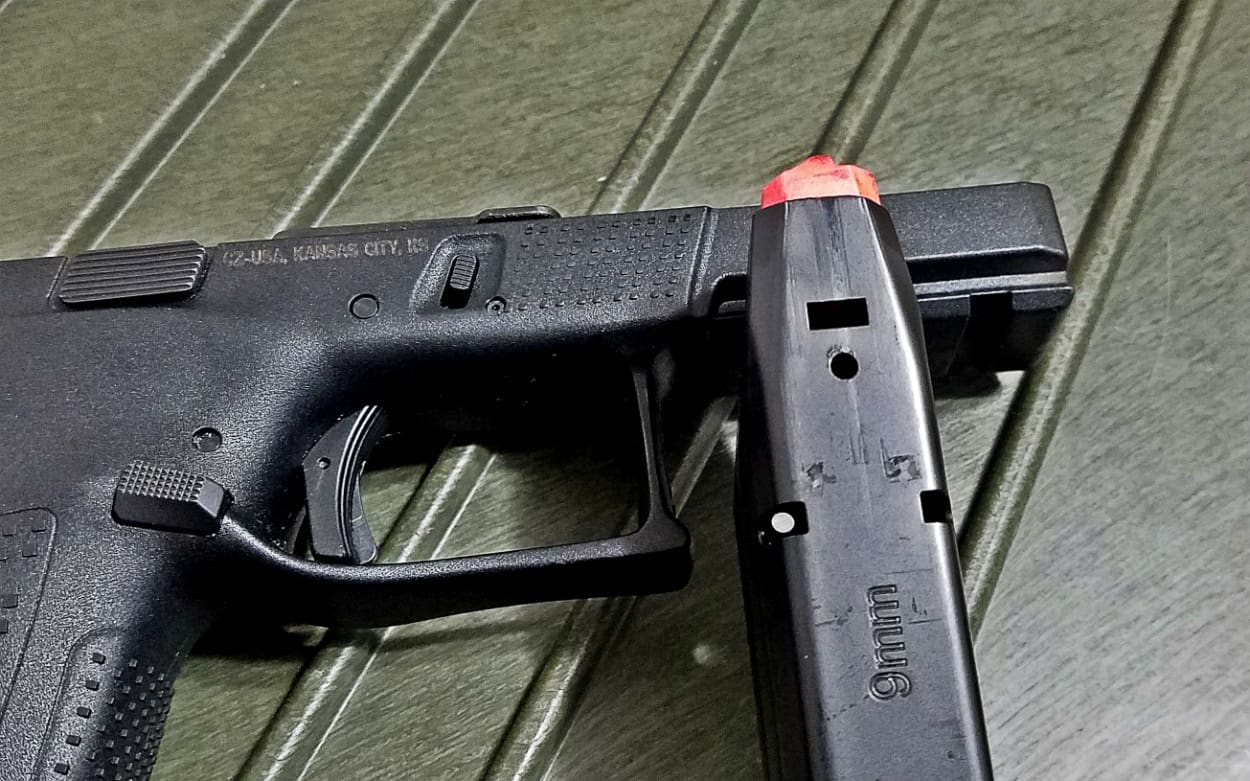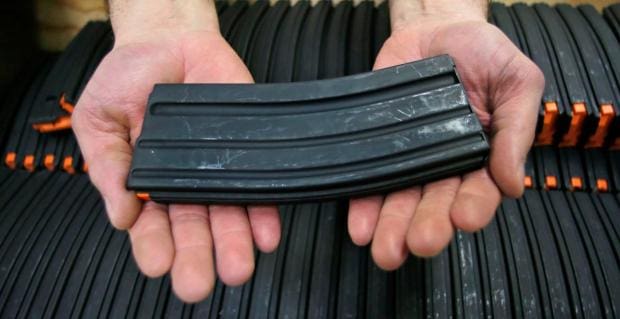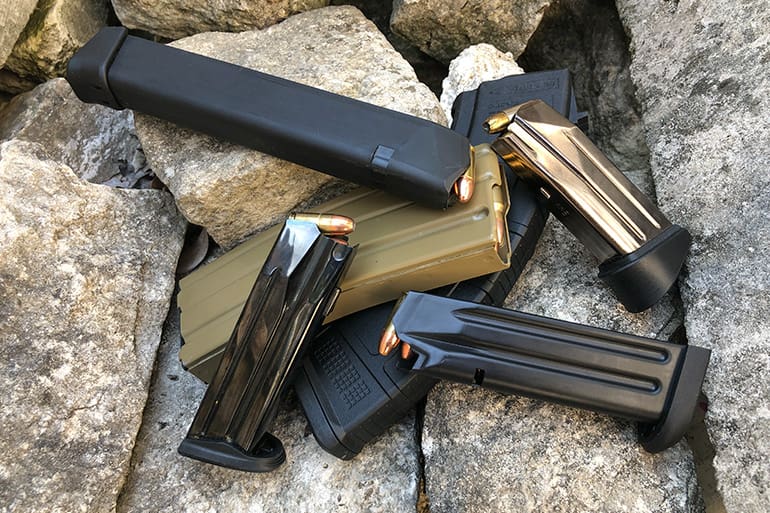By Lt. R. Michalik
Don’t underestimate the value of a bad ammunition magazine. If you’ve been around guns for any amount of time, you’ve almost certainly run into them. Whether you purchased a questionable no-name mag at a gun show or one came with your or your buddy’s gun, we have have experienced a magazine or two. It doesn’t matter if you own quality guns like a SIG SAUER, Smith & Wesson, GLOCK, FN, Ruger…whatever. Shoot them enough and magazines will eventually fail.
You can usually get them back into service and extend their useful lives by cleaning them and replacing followers and springs, but at some point, they’ll give up the ghost. Instead of throwing those bad handgun or rifle magazines away, though, here’s another idea.
Remember how to get to Carnegie Hall: practice, practice, practice. The same goes for getting good with your guns. And practice is especially important if your job involves carrying a firearm or if you take your own self-defense seriously.
Besides improving your marksmanship, some of us take it a step further by practicing firearm manipulation, mag changes and reloading with our off hand, one-hand drills and/or failure drills. We’ll even put dummy rounds in the mix and practice clearing a round.

But if you go to the range alone, it’s hard to surprise yourself. Drills can become rote and predictable. So why not deploy that bad mag to vary things?
You know the one. The magazine that jams every so often. The one that fails to pop the next round of ammo up leaving the chamber empty or the one that refuses the cleanly deliver a round leaving the pistol out of battery.
This isn’t a problem, it’s an opportunity.
I started collecting these magazines. Some were purchased on the cheap because I don’t like dumping my good factory mags if I don’t have to. Most were gifted to me by some very disgruntled shooters. And they’ve been invaluable as training aids for me and others. Especially since you can let the trainee load the magazine and they’re none the wiser to what lesson they’re about to face.

In my law enforcement career, I was a lead instructor for over seven years. I had an AR magazine that would jam every single round that went through it. Every officer who crossed its path the first time ended up doing the same thing. They would fool with it repeatedly until it was empty, wasting a lot of valuable time.
The next officer in line who witnessed the malfunctions would then do exactly the same thing. Only one person ever threw it down after three attempts and inserted a new magazine into their rifle.
A funny thing happened after that…the next officers up, after seeing that, then started discarding the bad magazine after a few attempts and loading a functional one.
Handling failures to feed is a critical part of your training. Practicing what to do and doing it quickly should become second nature to you. But that can’t happen unless you practice these situations. A lot. And it could very well save your life.
Equipment failures happen. They’re a fact of life when you’re a gun owner. They also seem to follow Murphy’s Law as they tend to happen at the most inopportune times. But the last thing you would want is to be taken completely by surprise and be unprepared in a time of crisis.
That bad magazine can be more valuable than a good one when used the right way in your training. That time spent dealing with a bad magazine might even save your life one day.





During the coronavirus scamdemic no toilet paper scare I made good use out of a lot of bad magazines.
Well played sir.
I took a lot of showers and washed a lot of towels.
In all seriousness, I know someone that installed a bidet. Not a fan of it. Trying to dry off after with TP just doesn’t work and the stream is a little discomforting. At least in the shower after a shart I can disinfect everything and use soap then dry off with a towel.
Anyways…
“Trying to dry off after with TP just doesn’t work and the stream is a little discomforting”
The Japanese make some nice ones. Instant-on warm water instead of cold goes a long ways. Not cheap, however. 🙁
Like you, I found the TP shortage to be no problem, since a shower was where I prefer to take a ‘pause for the cause’… 🙂
Hard to blow your nose on a magazine.
I actually had to write this down. I have not done malfunction drills in at least over a year. Since it’s warming up more of the group comes out from hibernation lol. Time for a refresher!
That was a very good article. I’ve used dummy rounds, short loaded mags so they went dry before the shooter’s expection, but I never intentionally introduced a defective magazine. That is a very good idea. I have had a bit of experience with defective magazines. Mostly AR mags. Until Mag-Pul. They at least solved that problem. Once though, a friend and I went in on 100+ Galil mags. Battlefield pickups, “as is” they were advertised in Shot Gun News. What the hell at that price. Some we just threw away. Obviously run over by armor. Others like new. Most in between and required a little work. Kept us busy in his LGS when the door was slow. My point is, I think the author missed another important use for damaged magazines. Cannibalize them for parts. Barring armor, something can usually be salvaged. And, if you’re like me you have lots of spare detachable magazines for every weapon that takes them. Never hurts to have the odd follower, spring, baseplate, or even mag body.
I RE: “I had an AR magazine that would jam every single round that went through it.”
That happens mostly when the spring does not apply enough pressure on the round’s primer end. Spring must push against the case with a bit more pressure on the primer end. Disassemble and debur the mag, with bolt closed depress mag catch and install empty mag, release mag catch. If mag engages catch it’s good, if not file the catch opening in the mag accordingly. Use 20 or 30 rd. Wolff replacement mag springs and anti tilt followers. I have 30s but much prefer using 20s.
The pnly mag I have that doesn’t work is a mag from an Enfield #4 I no longer own.
…just be sure to mark the unreliable/failure drill mags so they don’t get mixed in with the stuff that’s supposed to be reliable.
rosignol, there you go.
Absolutely! I am surprised that wasn’t mentioned in the article.
Yup. A spritz of orange paint on the base plate makes the “drill” mags easy to spot.
I use my janky mags for emergency reload and shoot-on-the-move drills, because I don’t care if they hit the ground and get scuffed.
Haz, never mind scuffed. That’s cosmetics. Watch out for those bent feed lips and dented mag bodies. The first will induce a failure to feed. The second will capture the follower. No bueno.
Leave the in democrat controlled city streets🤭
That there’s a great idea! Thin out the gangbanger herd.
It’s a useful idea, though my wife managed the same thing by buying me some cheap turkish 9mm for an IDPA match. Never realized how well I knew failure drills until that point. Didn’t really slow me down much but it was a good reminder of having the drill burned into your head.
I’ll put three rounds each in several magazines, randomly add single rounds to a few mags without looking, and practice whatever drill I’m in the mood to do. Not knowing when I’m going to run dry has been a helpful training aid, and it helps keep my overall round count low. I never thought of mixing in dummy rounds though – great idea!
This is great advice. Training for unexpected failures is an awesome thing too few people do and a bad mag is a perfect way to introduce some randomness. I’d also advise, if you load magazines the night before in front of the TV, deliberately randomize the number you load into each mag while not really paying attention so that when you’re shooting you can’t anticipate when you’re empty.
My EDC is a Glock 19, and a few years ago I found a local pawn shop selling used, OEM Glock 23 mags for $10 each, so I bought a few. Since the frame size is identical they lock into my G19 perfectly, but the 9mm rounds sit a bit higher on the feed lips than they’re supposed to (since, you know, .40 is obviously a larger diameter than 9mm). They’re great range mags because I don’t care if they get damaged AND the round sitting higher will invariably cause some sort of jam every few mags. Different types of failures too, so it’s a great training tool.
As others have noted, clearly marking bad magazines should occur to use this suggestion.
I disagree with the suggestion. I use dummy rounds to simulate failures during training. Load them randomly in magazines but keep track of the number so that all can be accounted for after training.
I distinctly remember experienced NCOs stomping a magazine once it was identified as bad. That way there was no risk of it being reissued. Turn it to the supply sergeant for replacement.
Funny thing, is I’ve been doing this for years, and never thought much about it. One of my Shooting Partners and my Best Friend, we’ve f**ked with each other for years slipping dummy rounds into each other’s ammo boxes (our Dummies look real because we handmade them).
I take care of my magazines, and it’s been a long time since I’ve had one fail on me. I won’t drill at our indoor range as most of the drills are taboo, So no mags are hitting the concrete.At our outdoor range, the grounds soft enough dropping one hasn’t damaged one yet.
The Mag for my old High Standard Model B cost $85, so I treat that sucker like it’s gold. Can’t afford to buy too many of those puppies.
Comments are closed.